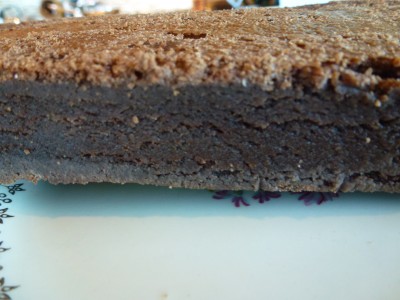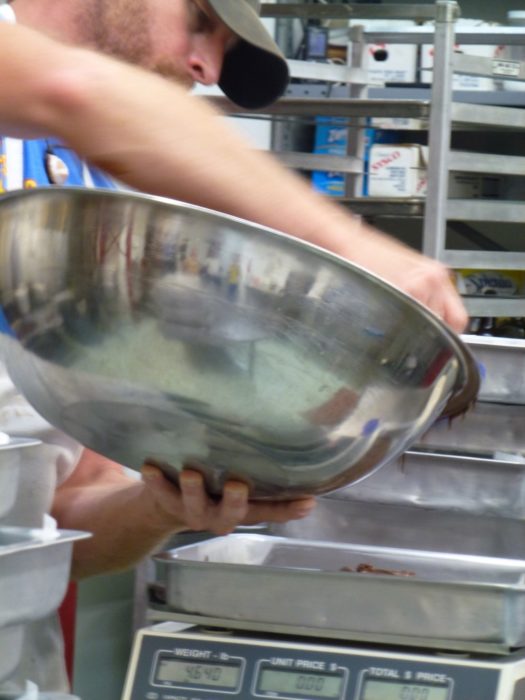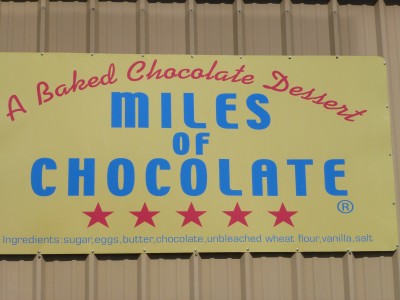“No cakey-ass brownies here,” declares Miles Compton about his baked chocolate dessert. In a food culture that insists on knowing the farmer who grows its corn and the exact percentage of butterfat in a cookie, how is it that Miles is so successful with his somehow unknowable chocolate dessert?

Long-time Austin food columnist, the late Katie Crider said that Mile’s dessert is “anything you want it to be.” And she was right. Virginia Wood, another Austin food writer said the dessert was “a cross between a brownie and a melt-in-your-mouth chocolate truffle. And she was also right. Unable to endure the suspense, I followed Miles’ directions, ate his chocolate dessert cold, and found it almost fudgy, full of intense quality dark chocolate, and was surprised that the top crust could retain such a light, crisp texture. I was beginning to see why his customers come back for seconds.
For sale in Whole Foods or Central Market in Texas, his chocolate dessert looks like a brownie. But it’s not. But it’s also not a gooey fudge-like cake. Sitting in its clear plastic store container, Miles’ dessert begs for answers. Why does this mysterious dessert have such a loyal following in a food culture that expects to know the ingredients of everything else?

Miles is good at creating the mystique that follows his desserts to the table. No amount of subterfuge will divulge the source of his chocolate or his recipe. His website flaunts his main ingredients, butter, eggs, chocolate. But that’s all. Nothing about local eggs, exotic Valharona chocolate, or hand-made butter. His customers apparently give him a pass, consuming hundreds of pounds of Miles of Chocolate, as it’s called, over the past decades.
Miles of Chocolate, made by Miles, an ex-Marine, has what marketers call “stickiness.” Not to be confused with how his chocolate creation can feel in your hands, the stickiness of his dessert is more about how his customers remain loyal as culinary trends change and warning from health officials about the detrimental effects of eating butter. In his book, The Tipping Point, Malcom Gladwell points out that some products will survive because of a particular quality. Miles has found the sweet spot that causes his customers to remain stuck on his desserts, in spite of his mysterious recipe and unimaginative packaging.
These nine-by-thirteen rectangles of chocolateness could be mistaken for large brownies. Brownies, so called because of their color (originally from molasses in the early recipes), made their appearance in the 1897 publication of the Sears Roebuck Catalog but were also consumed at the 1893 Columbian Exhibition in Chicago. Somehow, Miles has transformed this enduring confection into “crack disguised as the best brownie you’ve ever had,” as one Yelp review exclaimed.

Two people run Miles of Chocolate, Miles and his business partner Ben, both in business for about eight years. Over two decades ago, Miles’ hairdresser/astrologist consulted the stars and announced that Miles should be a chef. Beginning as a dishwasher, Miles began baking after several years as a chef, working in Corpus Christi and then Austin. He soon discovered and tweaked his chocolate dessert recipe, now the star attraction of his business. Five stars glow from his logo, a self-assured declaration familiar to restaurant reviewers.
Not content to rest on his laurels as a recipient of the Austin Chronicle’s award for the best local chocolate for four years running, Miles fits into Austin’s food scene by displaying a familiar creative resistance and nonconformity the local culture. By refusing to admit his dessert is a brownie and concocting it with unimaginable amounts of eggs and butter, he plays to Austin’s creative audacity, the same audacity that evoked the “cakey-ass” comment. And there’s plenty of evidence that he knows what he’s doing: his customers eat up his culinary attitude, coming back year after year. Thank the stars for Miles of Chocolate.

Author